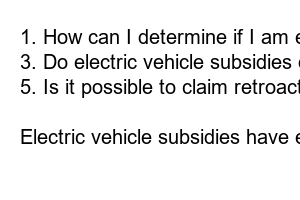전기차 보조금 조회
Title: Electric Vehicle Subsidy Inquiry: A Guide to Government Initiatives for Greener Transportation
Introduction:
As the world becomes increasingly aware of the need to reduce carbon emissions and combat climate change, the adoption of electric vehicles (EVs) has gained significant momentum. Governments worldwide are stepping up their efforts to incentivize the purchase of electric vehicles by offering subsidies. In this blog post, we will explore *everything* you need to know about electric vehicle subsidies and *how* they can make a difference.
1. What are Electric Vehicle Subsidies?
Electric vehicle subsidies are financial incentives provided by governments to encourage the adoption of electric vehicles. These subsidies aim to bridge the price gap between electric and traditional combustion engine vehicles, making EVs more affordable and appealing to potential buyers.
2. Types of Electric Vehicle Subsidies:
There are various types of electric vehicle subsidies offered around the globe. Some common forms include direct purchase incentives, tax credits, rebates, grants for charging infrastructure, and lower registration fees for EVs. The specifics of these subsidies can vary from country to country and even within regions.
3. Government Initiatives:
Governments all over the world have implemented different subsidy programs to boost the adoption of EVs. For instance, the United States offers a federal tax credit of up to $7,500 for the purchase of new electric vehicles. Similarly, Norway grants generous exemptions from tolls, parking fees, and road taxes to EV owners.
4. Impact on the Environment:
By encouraging the transition from conventional gasoline-powered vehicles to electric ones, these subsidies play a crucial role in reducing carbon emissions. EVs produce zero tailpipe emissions, resulting in improved air quality and a significant reduction in greenhouse gas emissions, helping combat climate change.
5. Economic and Social Benefits:
Electric vehicle subsidies not only contribute to a cleaner environment but also have positive impacts on the economy. Such incentives stimulate the growth of the EV market, leading to job creation and innovation in the renewable energy sector. Moreover, reduced reliance on fossil fuels enhances energy security and reduces oil imports.
6. Potential Challenges:
While electric vehicle subsidies are gaining popularity, there are still some challenges to overcome. Limited charging infrastructure, longer charging times compared to refueling, and higher upfront costs of EVs can discourage some potential buyers. However, continued government support and private investments are swiftly addressing these challenges.
Frequently Asked Questions (FAQs):
1. How can I determine if I am eligible for an electric vehicle subsidy?
2. Are there limits to the amount of subsidy available for electric vehicles?
3. Do electric vehicle subsidies differ from state to state?
4. Can electric vehicle subsidies be combined with other incentives?
5. Is it possible to claim retroactive electric vehicle subsidies?
6. Will the availability of subsidies change in the future?
Summary:
Electric vehicle subsidies have emerged as vital tools in accelerating the transition to sustainable transportation. Governments’ financial support not only promotes renewable energy but also benefits the environment, economy, and society as a whole. By incentivizing electric vehicle adoption, we can pave the way for a cleaner and greener future. So, take advantage of these subsidies and drive towards a *sustainable* tomorrow.

